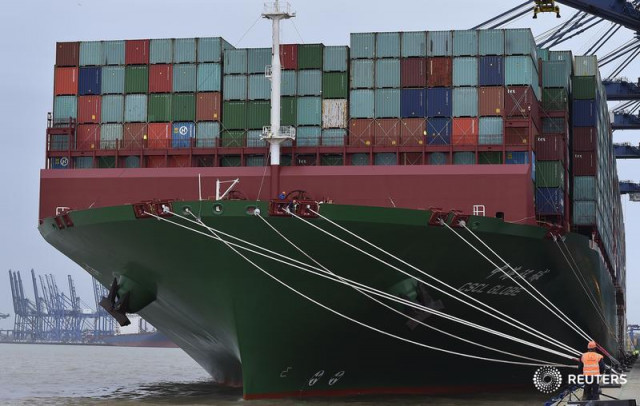After record high import bill, Pakistan's trade deficit widens to $33.9b
Country's import bill peaked to $5.8 billion in May; pressure on foreign currency reserves to continue

Country's import bill peaked to $5.8 billion in May; pressure on foreign currency reserves to continue. PHOTO: REUTERS
Pakistan has applied all administrative means, starting from introduction of cash margin requirements to imposition of heavy regulatory duties on imports, but nothing so far has worked. Even a 10% devaluation of the rupee in two rounds this fiscal year could not arrest the rising trend in the import bill. The central bank on Monday further devalued the currency by 4.3% due to worsening macroeconomic indicators.
The country booked an import bill of $5.81 billion in May - highest in history. But the increase in exports was outpaced by soaring imports.
The trade deficit widened 13.4% year-on-year to $33.9 billion in the cumulative eleven-month period (July-May), surpassing the revised estimated deficit for the entire fiscal year. Against the original trade deficit estimate of $25.7 billion, the Ministry of Finance had estimated that the deficit could swell to $29.4 billion for fiscal year 2017-18 due to higher imports.
Pakistan has $12.8b untapped potential for exports
The higher-than-officially-projected trade deficit in just eleven months will have adverse implications for both the current account deficit and foreign currency reserves. At the current pace of imports, the official gross foreign currency reserves, standing at $10 billion, are not sufficient for two months of imports.
Exports in July-May were up by 15.28 % to $21.4 billion, equal to 92.6% of the annual export target of $23.1 billion. In absolute terms, export receipts were up by $2.83 billion during the first eleven months.
The increase in exports came on back of rupee devaluation and subsidised loans given to the textile sector.
The value of imports stood at $55.23 billon, which was 14.1% or $6.83 billion higher than the import bill booked during the first eleven months of the last fiscal year. The eleven-month import bill exceeded even the revised annual estimates of $54.2 billion for the outgoing fiscal year.
Pakistan is expected to book a current account deficit of around $16 billion during the current fiscal year 2017-18, against the government's budgetary target of $9 billion.
The only good thing on the external front is steady growth in foreign remittances that partially offset the impact of growing trade deficit on the external account. During the first eleven months, foreign remittances amounted to $18 billion, registering almost 3% growth.
Pakistan’s trade deficit widens 14.3% to $29.8 billion
Annualised data
On a year-on-year basis, Pakistan's exports grew to $2.14 billion in May over the same month of the previous fiscal year, according to the PBS. Exports were higher by 32.4% or $524 million over the receipts of May 2017. It was the third consecutive month when exports remained above $2 billion.
Imports grew 14.8% to $5.8 billion in May - an increase of $748 million on an annualised basis. The increase in crude oil prices has kept imports under pressure. Although the eleven-month data was not still available, during the first ten months petroleum group imports amounted to $11.4 billion, constituting almost one-fourth of the total imports.
In comparison, the machinery group imports stood at $9.5 billion in the 10-month period, which were less than one-fifth of the total import bill of July-April.
The trade deficit in May widened to $3.7 billion - higher by 6.5% or $224 million.
Monthly results
On a month-on-month basis, exports in May nominally increased 0.52% to $2.14 billion over April. Imports in May surged 13.8% to $5.8 billion. The month-on-month trade deficit this time was up by 23.3% or $694 million.



















COMMENTS
Comments are moderated and generally will be posted if they are on-topic and not abusive.
For more information, please see our Comments FAQ